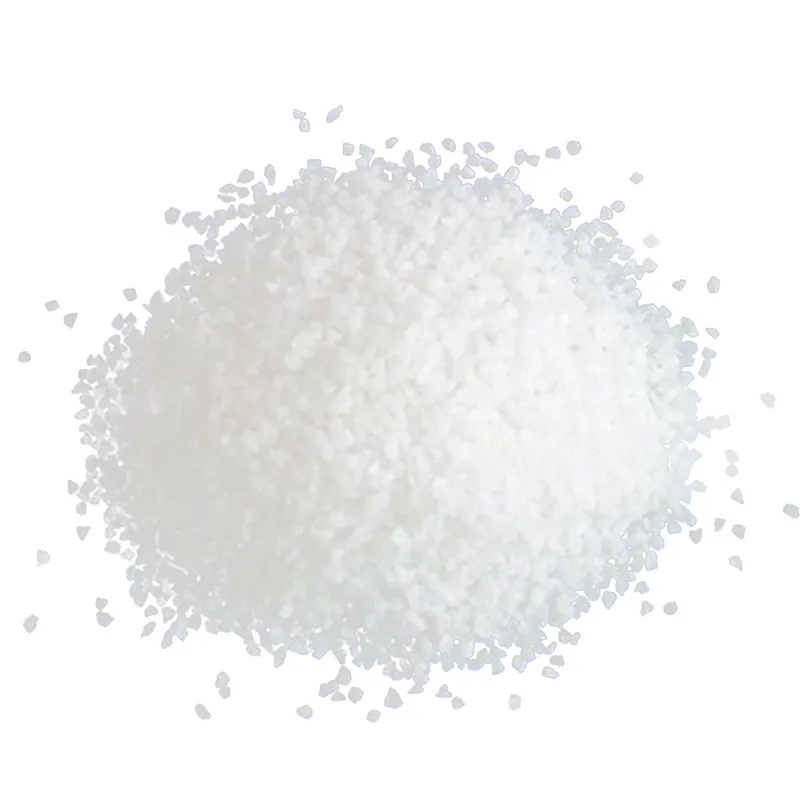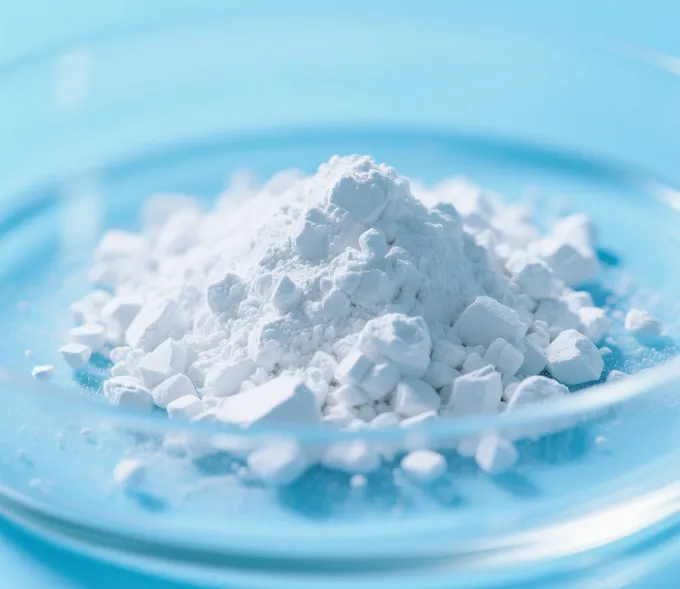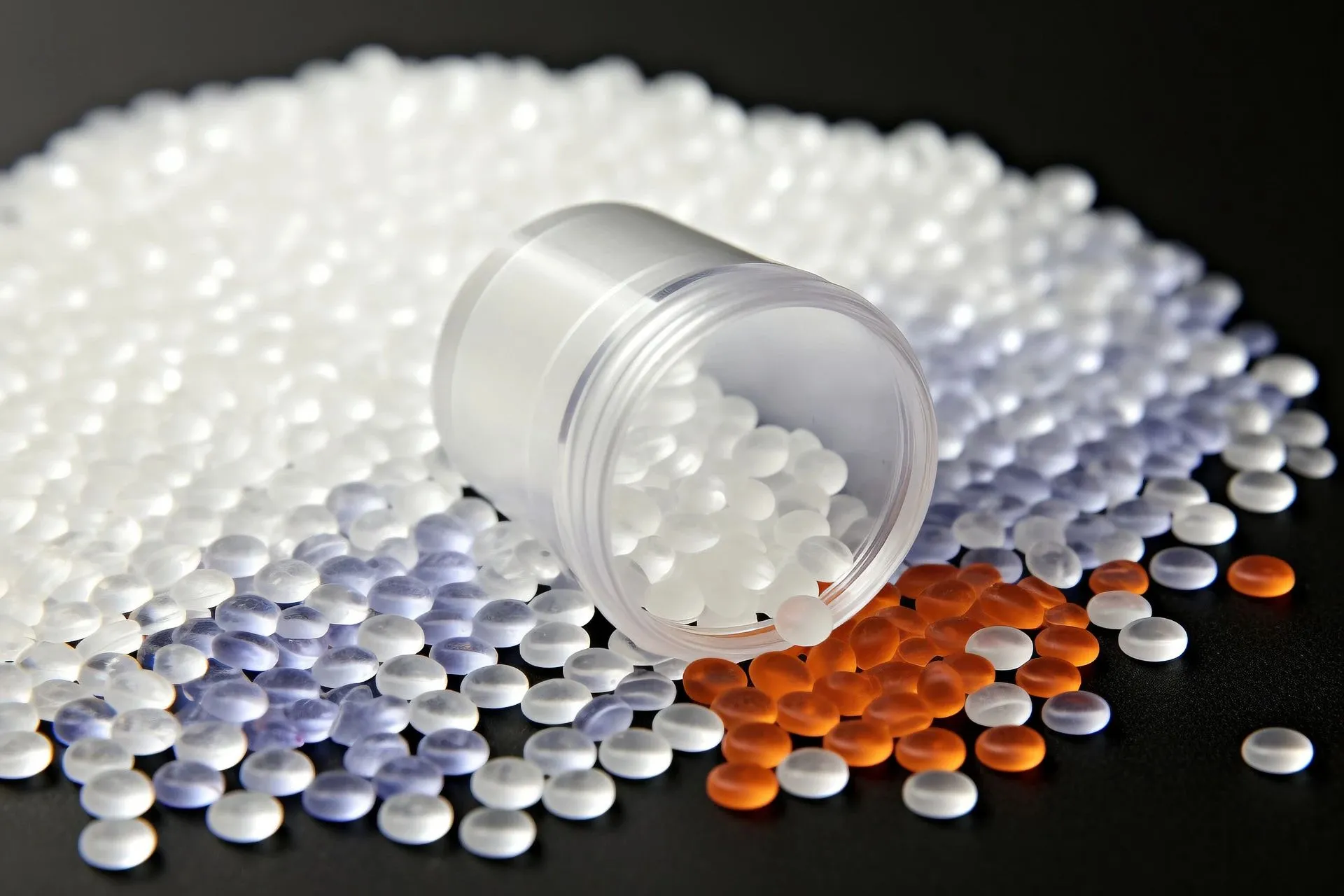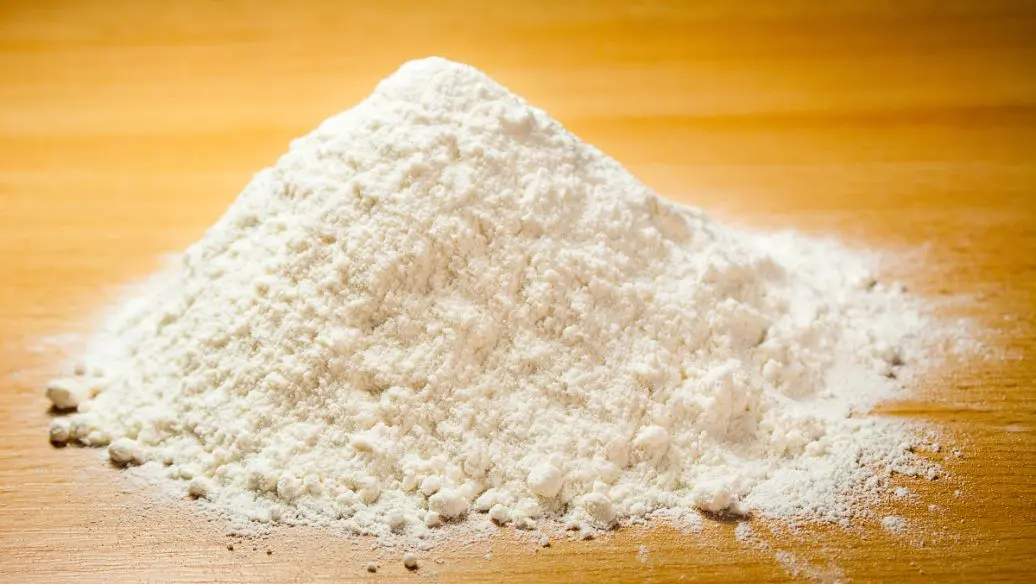In recent years, with the in-depth influence of AI, smartphones are gradually entering the “AI era”. On the one hand, AI brings users a simple and pleasant experience. On the other hand, the powerful computing power and the various functions of AI make mobile phones consume more power. Even with the continuous increase in mobile phone battery capacity and the continuous iteration of fast charging technology. The problem of “not enough power” is still a hurdle for many consumers and manufacturers. Based on this, silicon-carbon anode technology has become one of the most popular mobile phone battery solutions in recent years.
As the name suggests, silicon-carbon anode technology converts traditional graphite anode materials into silicon-carbon anode materials with higher specific capacity. It thereby greatly improves the battery energy density and capacity to solve the problem of insufficient power. When the size of the mobile phone remains unchanged and the power consumption becomes faster. With the unremitting efforts of industry practitioners, this technology is now blooming in major mobile phone brands. And it has even been promoted to other smart terminals such as tablets and wearable devices. Here are the most popular carbon-silicon anode batteries available now.
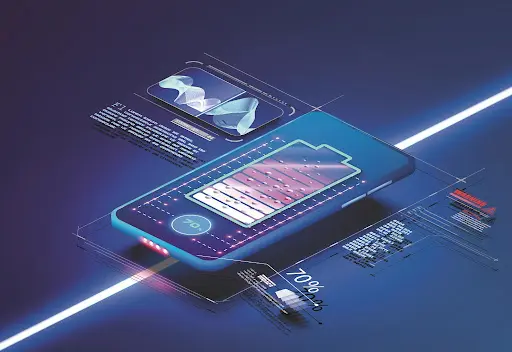
Silicon-carbon negative electrode battery technology
Technical principle
Silicon-carbon negative electrode battery technology is an emerging battery technology. It aims to improve the energy density and capacity by combining the advantages of silicon materials and carbon materials. The following is a brief summary of silicon-carbon negative electrode battery technology:

The principle of carbon anode battery technology is mainly based on the high theoretical specific capacity of silicon material and its unique alloying lithium storage mechanism. Silicon reacts with lithium to form an alloy with a theoretical specific capacity as high as 4200mAh/g. This is much higher than the 372mAh/g of traditional graphite materials. During the charge and discharge process, the silicon anode stores lithium by forming various alloy phases such as Li12Si7, Li13Si4, Li7Si3, and Li22Si5 with lithium. However, silicon can cause huge volume expansion and contraction during the alloying/dealloying process, leading to battery performance degradation. To solve this problem, silicon-carbon anode technology improves the volume expansion problem of silicon-based materials through nanotechnology, carbon coating etc. That can improve its conductivity and cycle stability. Silicon-carbon composite materials have become the preparation method with the fastest progress in industrialization. Becaus they have advantages such as good stability, small volume change and excellent electrical conductivity.
Technical advantages
After the introduction of silicon-carbon anode battery technology, it mainly brings the following advantages. First, it significantly improves the energy density of the battery. The theoretical specific capacity of silicon material is as high as 4200mAh/g, which is about 10 times that of graphite. It greatly improves the performance of lithium batteries. energy density. Secondly, silicon-carbon negative electrode batteries have higher safety performance. The lower lithium deintercalation potential avoids lithium precipitation on the surface during charging and reduces the risk of battery short circuit. Besides, the application of silicon-carbon anode materials can help reduce battery costs and increase the cruising range of electric vehicles. Finally, breakthroughs in silicon-carbon anode battery technology have caused battery capacity to grow at a rate of about 10% yearly. It is expected that battery capacity will reach 6000mAh in the future, providing users with a longer battery life experience.
Silicon carbon anode battery inventory
Carbon-silicon anode battery technology is currently mainly used in 3C electronic products. It has been widely and deeply used in the field of smartphones. According to incomplete statistics. Nearly 10 companies, including Honor, Huawei, Xiaomi, vivo, oppo, Lenovo, and Realme, have released six silicon-carbon negative electrode batteries. The details are as follows, in no particular order, listed by the first letter of the brand.
1. HONOR Glory
Qinghai Lake silicon carbon anode battery
The Qinghai Lake silicon carbon anode battery is an innovative battery technology independently developed by Honor. It was used for the first time in the Honor Magic5 series of mobile phones, especially the Honor Magic5 Pro model, which provides a large battery capacity of 5450mAh.
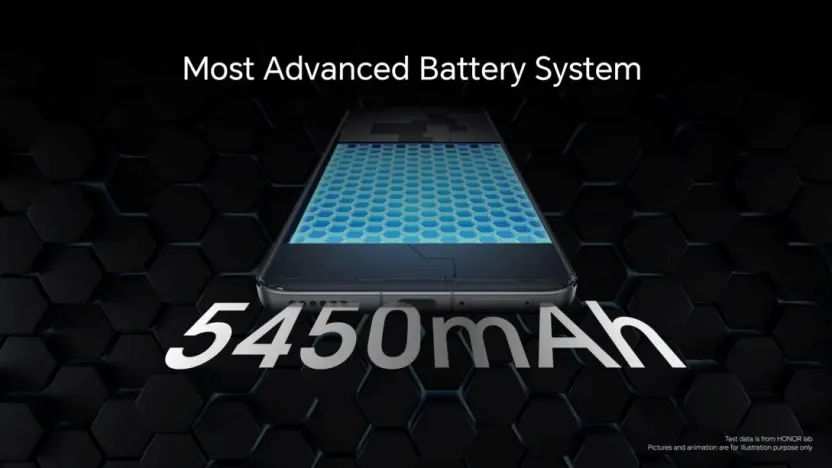
This technology takes full advantage of the fact that the theoretical gram capacity of silicon material is about 10 times that of graphite material. By using porous carbon skeleton and nano-silicon in-situ vapor deposition technology, it effectively improves the energy density and performance of the battery. Specifically, the porous carbon skeleton provides a three-dimensional conductive network that can absorb the volume expansion of the silicon material, reduce the stress during charge and discharge, and maintain the stability of the electrode structure; while the nano-silicon in-situ vapor deposition technology prepares the silicon material Being nano-sized particles further improves the electrochemical reaction efficiency of the battery.
These innovations have increased the negative electrode energy density of Qinghai Lake batteries by 16% compared with ordinary graphite negative electrode batteries. The second-generation Qinghai Lake battery technology has been further applied in the Honor Magic 6 mobile phone. Not only has the energy density been improved again, but it has also achieved a new breakthrough in low-temperature battery life technology in the industry, allowing users to use it normally even in harsh environments and extreme scenarios. This shows that Qinghai Lake silicon-carbon anode battery technology has significant potential and advantages in improving the battery life of smartphones.
2. HUAWEI
Huawei high silicon anode battery
Huawei has made significant progress in the field of battery technology, especially in the research and development of high-silicon anode batteries. This kind of battery uses silicon material as the negative electrode. Compared with traditional graphite negative electrodes, the silicon negative electrode has a higher theoretical specific capacity (up to 4200mAh/g), far exceeding graphite’s 372mAh/g. Huawei has improved the conductivity and stability of the silicon anode by optimizing the material ratio and microstructure. It has also solved the problem of volume expansion of silicon materials during charging and discharging, and improved the stability and cycle life of the battery. In the Huawei Mate Xs 2 Collector’s Edition, Huawei used this high-silicon negative electrode battery, achieving a battery capacity of 4880mAh while keeping the body light and thin.
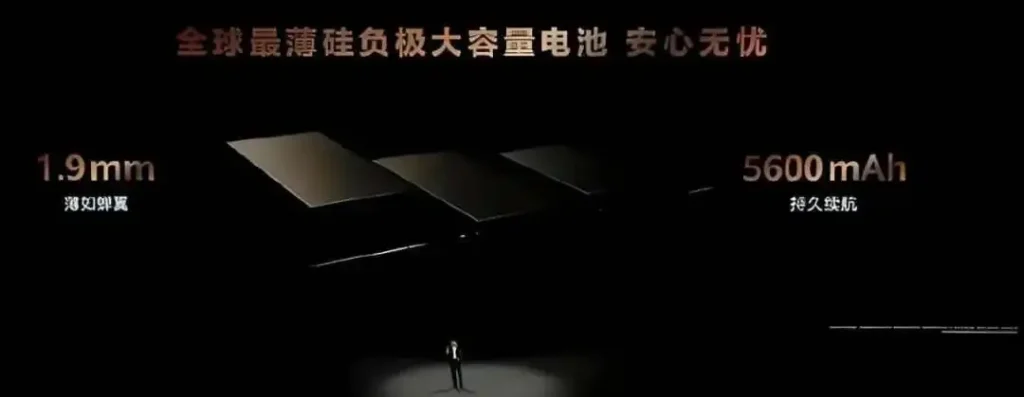
Huawei’s high-silicon negative electrode battery has received positive reviews from the market for its technological innovation and performance improvement. This battery not only improves energy density, but also achieves a breakthrough in battery capacity without a significant change in volume. Huawei uses carbon coating structure and innovative flexible polymer binder to inhibit expansion and shedding; uses lithium foil to supplement lithium, which increases the first charge and discharge efficiency by 26%; uses nano-carbon tube technology in silicon negative electrode batteries to increase conductivity by 4 times, further improving the performance of silicon negative electrode batteries.
3. Lenovo
Xinghai Battery
Xinghai Battery is Lenovo’s self-developed high-voltage silicon-carbon negative electrode battery technology, with an energy density of 822Wh/L, which exceeds the 809Wh/L of the vivo S19 straight-screen mobile phone. It is one of the most advanced technical solutions currently used in folding-screen mobile phones in the industry. The high energy density of Xinghai Battery means that more electricity can be stored in the same volume, thus providing longer battery life.
In terms of specific parameters, the moto razr 50 Ultra is equipped with a 4000mAh Xinghai battery and supports 68W fast charging technology. The standard version of moto razr 50 is equipped with a 4200mAh Xinghai battery, which supports 30W wired fast charging and 15W wireless charging. These parameters show that the Xinghai battery not only has high energy density, but also has the ability to charge quickly, providing users with a convenient power experience and a longer battery life.
4. Oppo
Glacier Battery
The Glacier Battery is a high-performance battery technology jointly developed by OPPO/OnePlus and CATL, designed for smartphones that pursue high-performance experience. This technology uses a new generation of silicon-carbon negative electrode battery technology. It has the characteristics of high energy density, small size, stable power output, long battery life and fast charging. The negative electrode silicon-carbon content of the Glacier Battery reaches the industry’s highest 6%. The energy density is as high as 763Wh/L, and the battery capacity reaches 6100mAh. Makes it the largest capacity that can be achieved in the industry’s silicon-carbon negative electrode battery. In addition, the volume of the Glacier Battery is 3% smaller than that of an ordinary 5000mAh graphite battery. It achieves a breakthrough in providing greater capacity in a smaller volume.
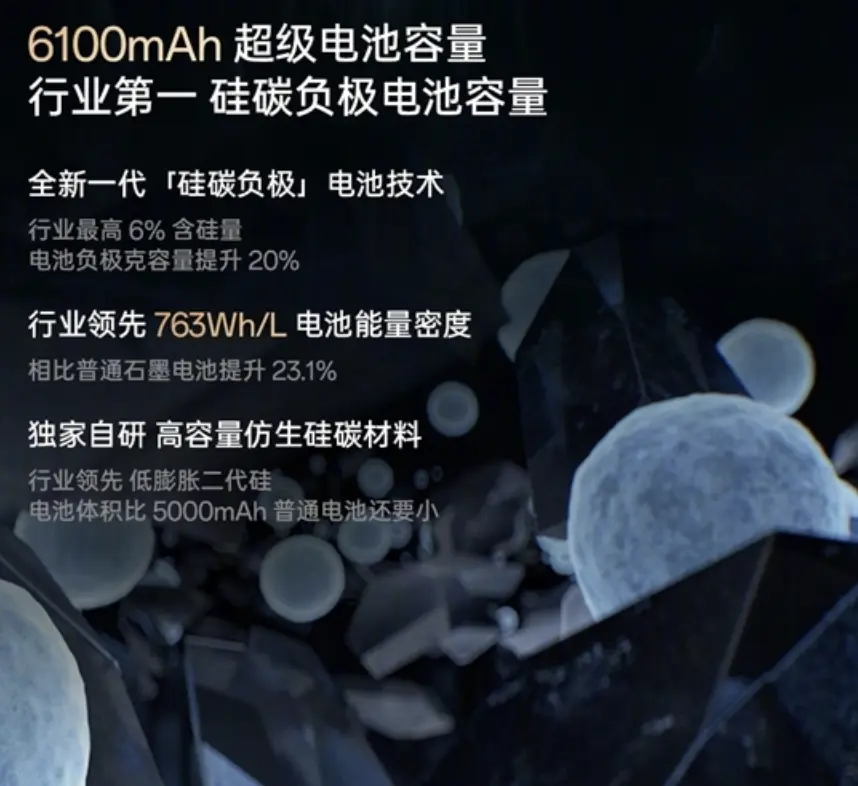
Glacier Battery not only has a large battery capacity, but also supports the longevity version of 100W super fast charging, which can fully charge a 6100mAh battery in 36 minutes. It is also the only mobile phone in the industry to achieve “6000+mAh battery + 100W fast charging”. In terms of life, Glacier claims that after four years of use, the battery life is at least 80%. It adopts a new self-developed “bionic honeycomb structure design” and “silicon carbon anode life algorithm” as well as a number of battery life technologies. These characteristics make Glacier Battery reach the industry-leading level in terms of battery life and charging speed, bringing users an ultra-long battery life experience.
5. Realme
Gathered energy battery
The realme concentrated battery is a highlight of the realme GT6 mobile phone. It uses a new generation of silicon-carbon anode battery technology with a silicon content of up to 6%. This technology increases the energy density of the battery by 8%. This battery technology not only improves the energy density, but also significantly improves the durability of the battery through the self-developed silicon carbon anode longevity algorithm. It claims to be able to maintain a four-year service life and has obtained the industry’s first SGS high energy efficiency silicon carbon Negative battery certification.
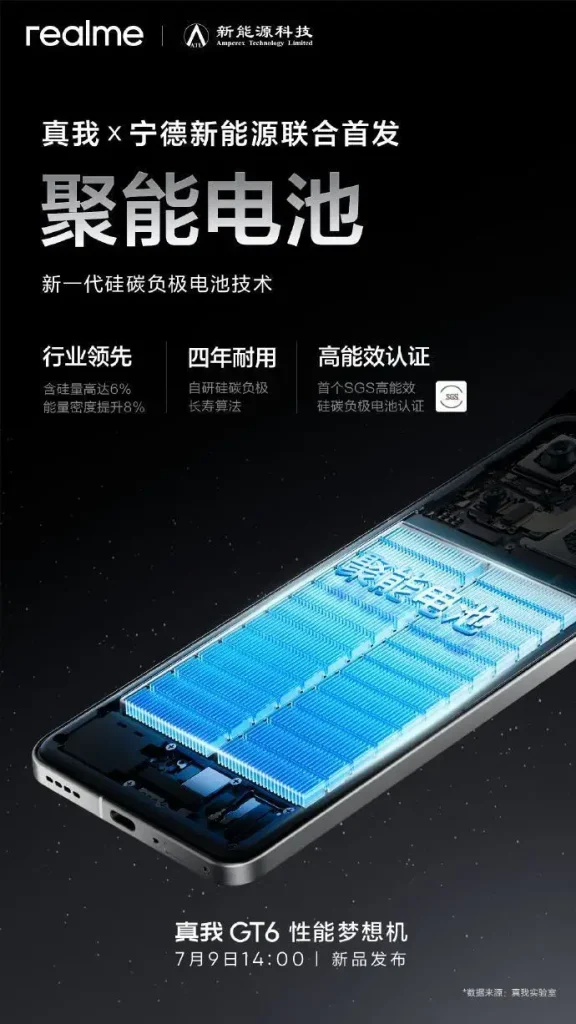
In addition, the Realme Energy Battery integrates a large capacity of 5800mAh in a thin and light body of 8.4mm, supports 120W ultra-100W flash charging, and can be charged to 50% in 12 minutes. It also supports UFCS/PPS multi-fast charging protocols, providing users with a convenient charging solution.
6. Vivo
Blue Ocean Battery
Blue Ocean Battery is a battery technology jointly developed by vivo and CATL. Its core feature is that it achieves comprehensive optimization of battery capacity, charging speed and battery life through innovative battery materials and structural design.
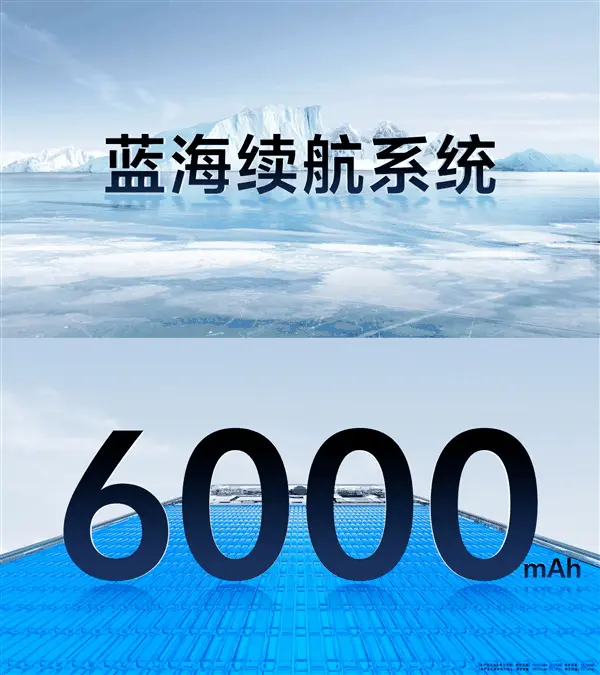
This technology uses negative electrode graphite reconstruction technology, super pole piece cold pressing technology and micron-level laser array etching technology to improve the battery energy density, making the vivo X100 Pro have an equivalent to 5400mAh ultra-large capacity and also support 100W dual-core flash charging technology. Blue Ocean Battery Technology achieves more energy storage in the same volume through the three major strategies of “open source, throttling, and efficiency improvement”, and achieves a 9% increase in energy density compared to traditional graphite batteries.
Blue Ocean Battery Technology also pays special attention to performance in low temperature environments. Through semi-solid battery technology, solid electrolytes are added to liquid electrolytes to form an additional conductive network. It ensures the normal transportation of energy and providing a battery life experience that is not afraid of low temperatures. Besides, the upgraded Blue Ocean battery in the vivo X Fold3 series is equipped with a Blue Ocean battery. The negative electrode material uses second-generation silicon, and the energy density reaches 780Wh/L. So it is 15.4% higher than the previous generation.
7. MI
Jinshajiang Battery
Jinshajiang Battery is a high-performance battery developed by Xiaomi and was first used in the Xiaomi 14 Ultra mobile phone. This battery is known for its high energy density, reaching 779Wh/L, which has the highest energy density in Xiaomi’s history. Jinshajiang battery uses the latest generation of silicon-carbon negative electrode technology. Its silicon content of up to 6%, and supports 80% battery life after 1,600 cycles. In terms of volume, Jinshajiang battery is 8% smaller than the previous generation. And the battery capacity is increased to 5300mAh, and the battery life is increased by 17%.
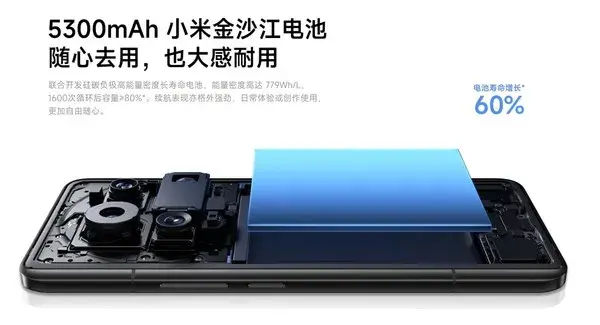
Jinshajiang Battery also forms a bionic self-healing elastic barrier by adding organic polymer compounds and in-situ film formation technology, which greatly enhances the ductility of the film and promptly repairs particle cracks generated during multiple cycles. The battery also uses high-strength copper foil and high-toughness adhesive to ensure its excellent performance. In terms of technology, Jinshajiang battery uses energy tank technology to form 2376 flow channels on the surface of the pole piece. It increases the contact area between the electrolyte and the piece and improves the energy density of the battery. The application of these technologies has significantly improved the capacity, durability and safety of Jinshajiang batteries.
Summary
As smartphones become more and more feature-rich and powerful, they also face the challenge of insufficient battery life. Silicon-carbon anode battery technology has become an effective solution to this problem with its high energy density and capacity. This technology significantly improves battery performance by combining the high theoretical specific capacity of silicon materials with the stability of carbon material. It can reduce both costs and improve battery safety and cycle life. According to statistics, silicon-carbon anode battery technology has been applied in nearly 10 brands of smartphones. It undoubtedly shows its huge potential in improving battery capacity and endurance. As technology continues to optimize, battery capacity is expected to grow at a rate of approximately 10% yearly in future. It can provide users with a longer battery life experience.

